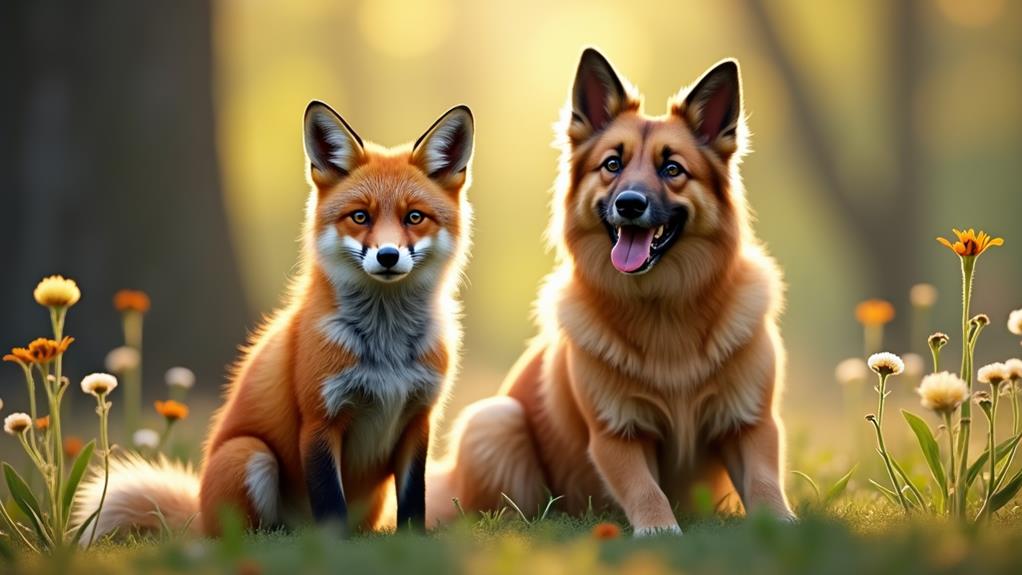Red foxes and dogs may seem different, but they're actually distant relatives in the Canidae family! About 7 to 10 million years ago, they shared common ancestors. Foxes are primarily solitary hunters, while dogs love being in packs, showing just how their lifestyles evolved. While red foxes have a unique musk and sleek coats, dogs flaunt a rainbow of colors thanks to selective breeding. Although foxes and dogs can interact in urban areas, they don't mate or make hybrids due to their genetic differences. Stick around, and you'll uncover even more cool facts about these fascinating creatures!
Contents
Overview of the Canidae Family
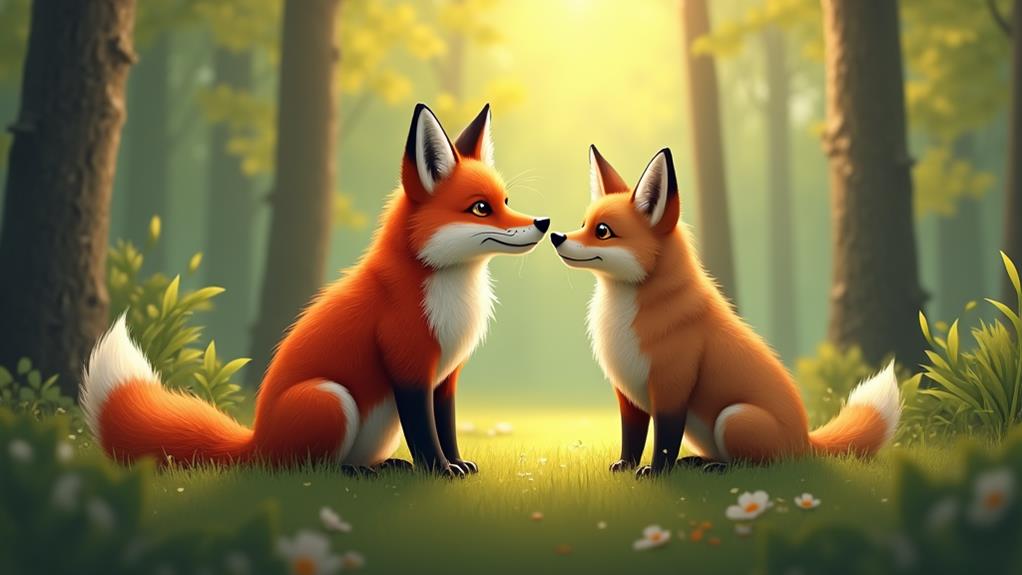
The Canidae family, often referred to as the dog family, comprises a wide variety of mammals including domestic dogs, wolves, coyotes, and foxes. You might find it fascinating that within this diverse group, foxes and dogs share common ancestors, which makes them cousins of sorts!
They both belong to the Canidae family, but they took different paths in their evolutionary journey about 7 to 10 million years ago. Foxes, classified mainly under the genus *Vulpes*, are known for their solitary hunting style, while domestic dogs belong to the genus *Canis* and thrive in packs.
Curiously, foxes come in various species such as the red fox and the fennec fox, showcasing their adaptability to diverse habitats. What's even cooler is that both foxes and dogs are omnivores. That means they enjoy a mix of animal and plant foods—talk about a flexible diet!
While foxes may prefer to roam alone, dogs are the social butterflies of the animal world, forming close-knit bonds with their humans and fellow canines. Understanding the relationship between these two canids is like appreciating different flavors in a delightful meal.
Each brings something special to the table, showcasing the rich tapestry of life within the Canidae family. So, let's celebrate these amazing creatures together!
Physical Characteristics Comparison
When you look at red foxes and dogs side by side, it's like comparing apples and oranges—both are fruit, but oh so different!
Red foxes are usually smaller and sport distinctive reddish coats, while dogs come in all shapes and sizes, often with fur colors that can rival a rainbow.
Plus, their faces tell different stories, with foxes having those sly expressions and dogs sporting a variety of goofy grins; it's clear that nature had some fun in the design department!
Size and Shape Differences
Size and shape differences between red foxes and dogs highlight their adaptation to different environments and lifestyles. When you think about foxes, you might picture a sleek creature weighing between 7 to 15 pounds, quite different from the many shapes and sizes of domestic dogs. They can weigh anywhere from 5 pounds to more than 100 pounds!
Red foxes are adept at thriving in diverse environments, including urban areas, expressing their physical characteristics through agile movements and stealth effective hunting. Foxes are generally slimmer and longer, making them agile hunters, while dogs boast a range of builds from slender to sturdy.
Ever noticed how foxes have flatter skulls and pointed ears, giving them that cat-like look? In contrast, dogs' snouts are often longer and wider, thanks to selective breeding.
Foxes flaunt their long, narrow limbs and bushy tails, perfect for darting through underbrush. Meanwhile, dogs might've legs and tails that come in all sorts of shapes and lengths—sometimes they look like they're ready for a sprint, while other times, they seem built for cozy lounging on your couch!
Understanding these differences helps you appreciate both the wild beauty of foxes and the diverse charm of your beloved domestic dogs. After all, they each bring something unique to the table!
Coat Variation Comparison
Coat variation between red foxes and domestic dogs reveals fascinating insights into their respective adaptations and lineage. When you look at red foxes, you can't help but notice their attractive reddish or yellowish-red coats paired with a lovely white underside. They almost seem to say, "Look how cute I am!" Their dense, soft fur keeps them warm, especially in chilly weather.
On the flip side, domestic dogs present a stunning variety in coat colors and patterns, thanks to selective breeding. Some might've fluffy coats, while others sport sleek, short hair.
Did you ever think about how the coat affects scent? Foxes have a distinct musky odor, while dogs' scents can change based on what they eat or how often they get groomed. Plus, those bushy tails of foxes help with balance during their graceful sprints, unlike dogs, which can have all sorts of tail shapes.
Both foxes and dogs do shed, but their shedding seasons may differ. All these coat variations highlight their adaptations, making each animal unique. There's so much to appreciate in their differences, don't you think?
Facial Features Distinctions
Looking at the physical attributes of red foxes compared to domestic dogs, their facial features offer a striking contrast. You'll notice that red foxes have slimmer faces with a pointed snout, whereas dogs come in all shapes and sizes—all thanks to their many breeds. It's like a dog-shaped buffet out there!
One of the coolest differences lies in their eyes. Foxes have vertical pupils, giving them a cat-like look and impressive night vision. Meanwhile, most dog breeds sport round pupils, perfect for those daytime adventures.
Now, let's talk ears. Red foxes flaunt large, triangular ears that enhance their hearing. They're like furry satellite dishes! In contrast, dogs can have upright or floppy ears, which can make them look utterly adorable.
Don't forget the fluffy tails! Foxes have bushy tails that help with balance and even communicate their moods. Dogs? Well, their tails vary just as wildly as their face shapes, often swinging joyfully with excitement.
Hunting Techniques: Foxes vs. Dogs
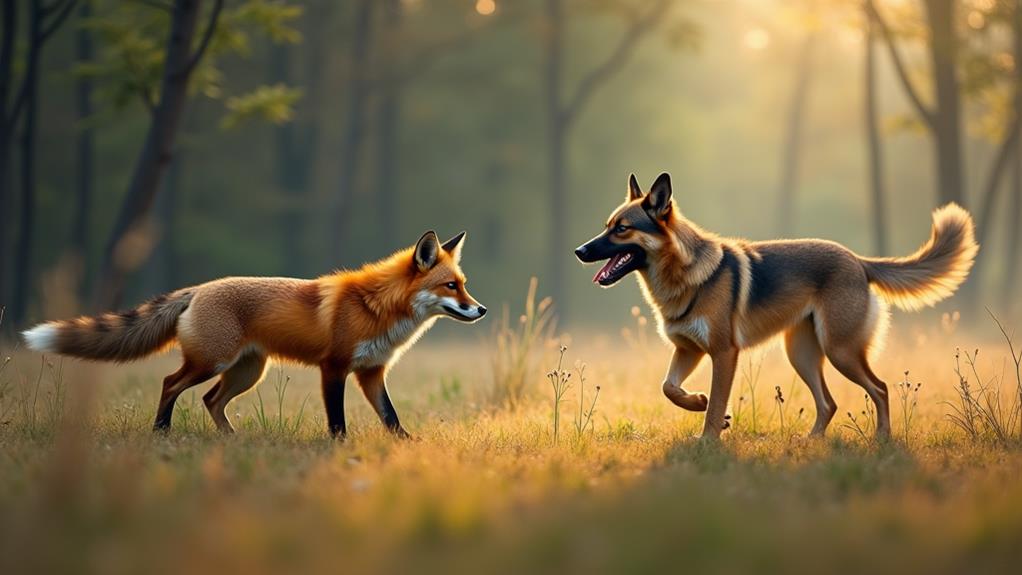
When you think about how foxes and dogs hunt, it's pretty fascinating to see their different styles.
Foxes are like the sneaky ninjas of the animal world, using their stalking and pouncing skills to catch their dinner solo.
In contrast, dogs team up and play the role of the endurance athletes, chasing down prey in packs like they're in a well-coordinated relay race!
Stalking and Pouncing Strategies
While foxes and dogs share similarities in their predatory instincts, their stalking and pouncing strategies showcase distinct differences rooted in their adaptive behaviors. Approximately 70% of urban foxes exhibit thriving behaviors in cities due to their flexible hunting styles and dietary adjustments, which allow them to make the most out of their urban environments, urban adaptation becoming key to their survival.
Foxes, those clever little creatures, have a unique approach. Imagine them sneaking through tall grass, using their stealth and agility like a cat on a prowl. Their long, narrow teeth help them deliver a precise killing bite—no biting off more than they can chew!
In contrast, dogs tend to hunt in packs. They rely on teamwork and communicate, which can seem more friendly than furtive. Picture a cheerful group of dogs strategizing over a mealtime plan, while a fox quietly stalks its dinner all by itself.
Foxes prefer those quiet, low-light conditions at night, where they can outsmart their prey with well-timed pounces. They're like that track star who knows just when to leap ahead!
Both dogs and wild animals are remarkable hunters, but their techniques remind us of their different lifestyles and environments. So, the next time you spot a fox or a dog, think of the unique strategies they employ to thrive in our world. They're clever in their own ways, aren't they?
Solitary vs. Pack Hunting
Foxes and dogs showcase fascinating differences in their hunting techniques, particularly when it comes to their social structures. Red foxes prefer a solitary approach, using their stealth and agility to stalk and pounce on prey like little feline ninjas. When you watch a fox hunt, it's like observing an artist at work, where precision is key. They deliver a quick, lethal bite.
On the other hand, dogs thrive in packs. They work together with their buddies, using endurance and teamwork to wear down their prey. Think of it like a game of tug-of-war, only with much more at stake!
In the hunting arena, foxes engage in playful interactions with their catch, reflecting their individual hunting style, while dogs enjoy vocalizations to coordinate their efforts. The anatomical differences play a role too; foxes have long, narrow teeth made for biting precisely, while dogs have stronger jaws better suited for shaking their prey in the name of teamwork.
Social Structures and Behavior
The social structures and behaviors of red foxes and domestic dogs highlight their differing survival strategies and social interactions. Red foxes are pretty much the lone wolves of the animal world—well, technically not wolves! These crafty critters prefer to hunt solo, showcasing a shy and cautious behavior.
Dogs, on the other hand, thrive in packs, forming strong bonds with both their fellow canines and their human companions. Isn't that heartwarming?
While foxes may nip when frightened, dogs are more likely to wag their tails and bring you joy. They've been socialized over thousands of years to be friendly and approachable. This makes dogs fantastic companions, always ready to play fetch or curl up on your lap.
Interestingly, coyotes, the cousins of both foxes and dogs, have a bit of a mixed bag when it comes to social behavior. They can form packs or choose to roam alone, blending the two styles.
Both species communicate through vocalizations, but the purpose differs. Dogs bark to say, "Let's be friends!" while foxes' calls carry more caution.
Myths and Misconceptions
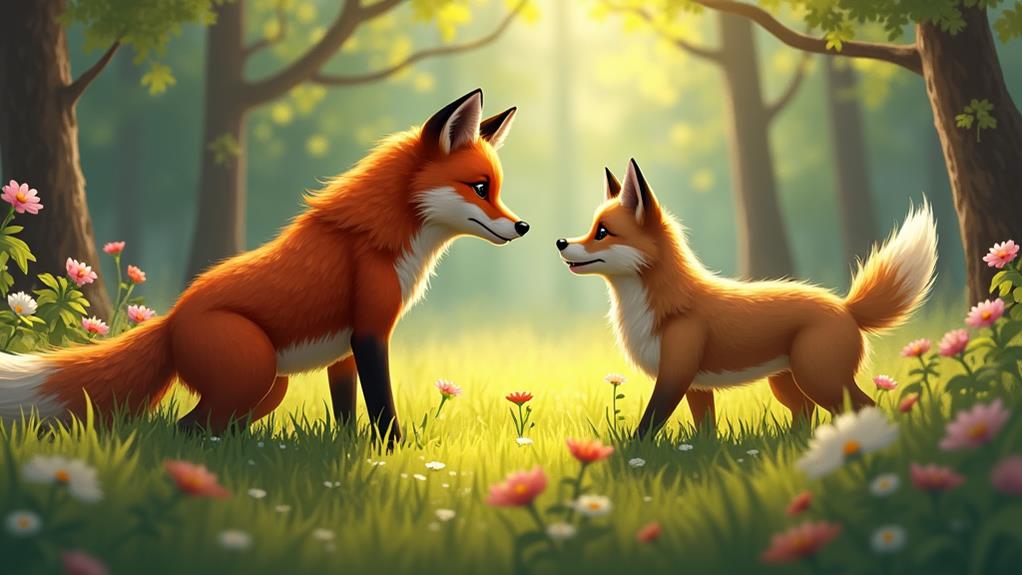
Many people hold onto common myths about red foxes that simply aren't true. For instance, you might hear someone call a fox a "feline dog." While they've some cat-like traits, red foxes are canines, more closely related to your pet dog than a cat. It's important to remember that foxes belong to the Canidae family, not the feline family.
Another myth is that foxes can mate with dogs. However, that isn't possible due to significant genetic differences. Did you know that foxes have 34 chromosomes while dogs boast 78? That's a big gap!
And what about those stories you hear about foxes attacking dogs? They're extremely rare! Typically, a fox would only behave aggressively if it felt threatened, which sensational media often exaggerate.
Lastly, as urban areas grow, foxes might come closer to homes, leading to misunderstandings about their behavior. You shouldn't fear these clever animals!
Pet Ownership Considerations
Considering a fox as a pet can be tempting, but it's important to recognize that these wild animals come with unique challenges. Unlike dogs, foxes aren't as easy to train—they tend to be shy and can exhibit unpredictable behaviors. Imagine trying to teach a fox to fetch! You'd likely find yourself playing a rather different game.
One major pet ownership consideration is the legal aspect. Many places regulate or even prohibit fox ownership, so understanding your local laws is vital. You wouldn't want to end up in a sticky situation, right?
Moreover, foxes require large enclosures and a lot of socialization from a young age, which can be quite demanding compared to the more manageable nature of dogs.
When it comes to odors, be ready! Foxes have a distinct musky smell that could fill your home quicker than a sneeze after opening a pepper jar.
Ultimately, while both dogs and foxes share a family tree, dogs make far more delightful companions. They love to cuddle, obey commands, and generally don't leave you questioning your life choices.
Hybridization Possibilities
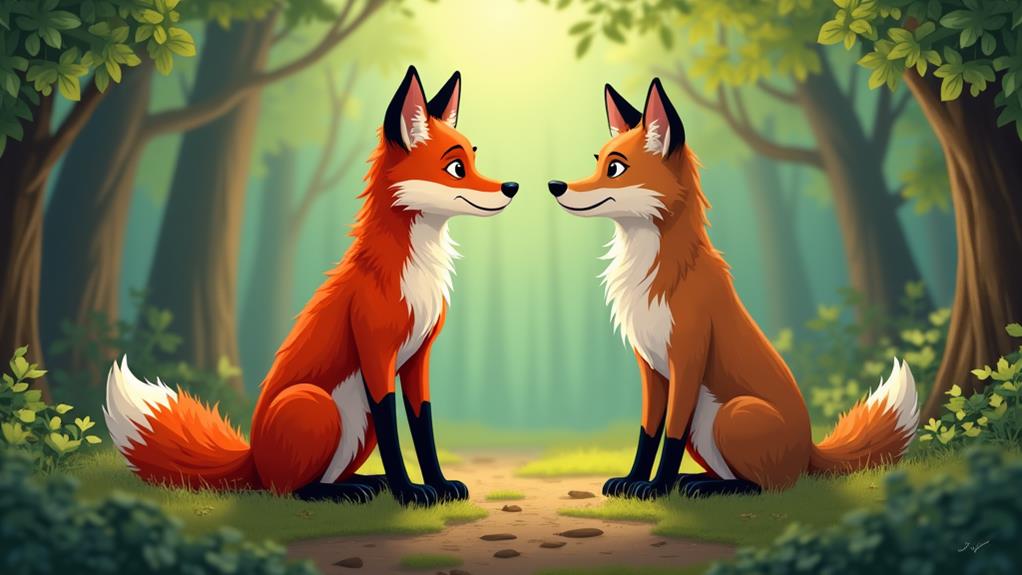
While dogs and foxes share a common ancestry, they're fundamentally distinct in their biological makeup, particularly when it comes to hybridization possibilities.
You might think that since they belong to the same Canidae family, creating a fantastic "fox-dog" hybrid could be possible, but that's not the case. The key issue here is the different numbers of chromosomes—foxes have 34, while dogs have 78. Imagine trying to fit two puzzles together when the pieces don't match; it just doesn't work!
Over 7 million years of evolution has really set these two apart, ensuring their reproductive systems are incompatible.
So, all those cute ideas about "doxes" are just that—ideas. There's no scientific evidence supporting the existence of any fox-dog hybrids.
Now, it's important to recognize that while foxes might enjoy socializing with dogs, they aren't hitting it off romantically!
In the end, knowing these facts helps us better appreciate the beauty of both species, no matter how much you might want to see them share a family tree.
Interaction in Urban Environments
As urban environments expand, red foxes and dogs increasingly share the same spaces, leading to fascinating interactions.
Imagine this: both species, adapting to life alongside humans, sometimes cross paths in parks or residential areas. Red foxes often prefer the night to avoid us, while your domesticated dogs are out and about during the day. This difference in schedules can create a buffer, but sometimes they still meet.
You might wonder—are red foxes a threat to our furry friends? Generally, they aren't. Attacks are rare and usually happen only if a fox feels cornered. That's a relief, right?
However, the presence of these wild canids can change your dog's behavior. Many dogs might become more alert or feel a bit more territorial when they sense red foxes nearby. They might even act like they're guarding the territory—like little superhero pups!
Final Thoughts
In summary, red foxes and dogs are like distant cousins in the big family of canines, sharing traits yet living quite differently. While they might seem worlds apart, their connection is fascinating! Whether you're considering a pet or simply enjoying their unique quirks in town, it's clear that these clever creatures add a sprinkle of wild charm to our lives. So, next time you spot a fox, remember—it's like spotting a furry ninja on the prowl!

